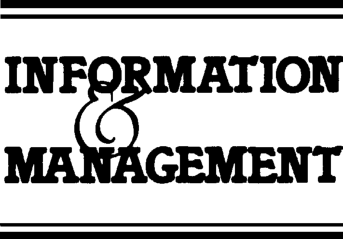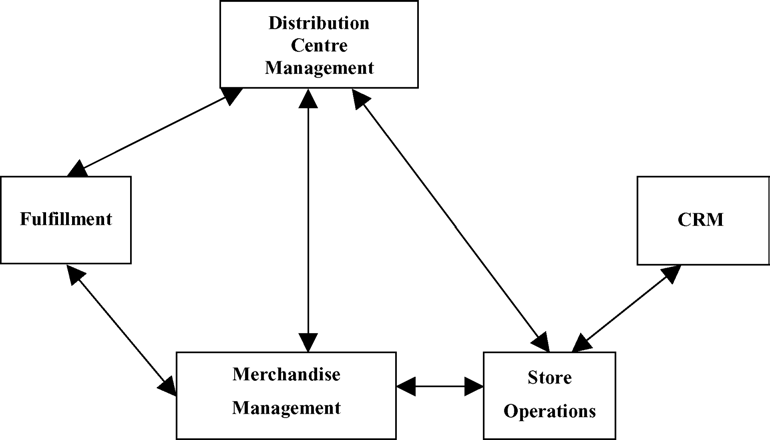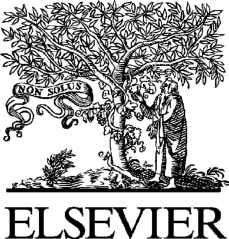And merchandise search intra extra store
 |
 |
|
|---|---|---|
| Information & Management 42 (2005) 921–933 |
www.elsevier.com/locate/dsw
Abstract
The full potential of the expected role of Information Technology (IT) in facilitating organizational adaptation has not yet been realized because most of the existing systems do not lend themselves to the levels of flexibility required to support changes in business processes. This problem is accentuated with increase of inter-organizational linkages involving disparate IT systems. Web services have emerged as a disruptive technology, with a real potential of enabling flexible business processes. This paper examines the influence of Web services on business process flexibility and analyses its impact on organizational adaptation.
economical, and reliable manner without compromis-ing organizational flexibility. This brings into focus the role of flexible business processes in enabling organizational adaptation. Organizations operating in dynamic environments need to transform continuously in order to create and sustain competitive advantage. The challenge is therefore to address the problems associated with the flexibility of business processes
while taking into account the existing legacy IT
building them but they play only a limited role in achieving the desired levels of flexibility. Business processes are activities structured and organized
| 922 | to | a | interactions. | It | is | |||||||
|---|---|---|---|---|---|---|---|---|---|---|---|---|
| according | predefined | flow | that | allow | machine-to-machine | |||||||
organization to carry out its business. Many of the business processes require process interdependencies and system dependencies that are established through integration of the business processes.
Studies of firms that adapt, survive, and create sustainable competitive advantage in dynamic envir-onments show that they respond to the changing environment with appropriate strategic moves. Such firms exhibit a ‘‘sense and respond’’ capability, and succeed by acquiring new resources and capabilities and modifying existing resources, and capabilities. Flexible business processes are a key capability of such organizations, and therefore identification and selection of appropriate business processes assumes importance. IT has been proved to be one of the key resources aiding an organization to achieve compe-titive advantage [7,21,28]. Byrd and Turner [4] establish the relationship between flexible IT infra-structure and competitive advantage. Defining and implementing flexible business processes supported by flexible IT systems is of significance to organiza-tions because this would allow them to collaborate with partners in new ways resulting in inimitability of the processes, and this in turn allows them to adapt to the changing environment. Flexible IT systems are
| change [18]. Technologies such as Web services, | concept | of | adaptive | behavior | in |
|
|---|
which allow applications interaction across firm boundaries economically and incrementally, have transformed the nature of inter-organizational com-merce. Web services make available open and standardized interfaces, allowing for the encapsulation and componentization of software and applications,
must make to the strategy and structure of a company [19,14,34]. These contrasting perspectives are found
D. Moitra, J. Ganesh / Information & Management 42 (2005) 921–933 923
whose interfaces and bindings are capable of being defined, described, and discovered as XML artifacts. Web services support direct interactions with other
the firm to adapt. The state of adaptation in a firm is software agents using XML based messages,
� loosely coupled;
� dynamically bound;
� accessed over the Web;
� standards based (see Appendix 1 for various Web services standards).Web services can be published, located, and inv-oked by other applications over the Internet. When the applications follow such standards, they can inter-operate. Web services can integrate applications wr-itten in different languages as well as run on disparate platforms. This allows enterprises to effectively reuse business functionalities and reduce the time to respond
seeking to survive and capitalize on external chitectures (SOA). SOAwould allow service providers
circumstances [15,36]. Organizations survive by to publish services, which may be accessed by the
seamless and flexible interaction across applications
within and across firm boundaries. The term Web services denotes a group of technologies that allow business processes or information to be accessed over the Internet. Web services are designed to support application-to-application interaction. This technol-ogy allows applications to communicate without human assistance. Two key aspects are that they are invoked and delivered through the Internet and they provide a standard interface. Web services can be accessed by disparate devices from handheld devices to large servers.
Fig. 1. Web Services Architecture. Source: W3C Web services Architecture Working Group.
different software components required for these In the first stage of our work, we conducted extensive
As the adoption of Web services is still in its early stages, we conducted exploratory research with the business process as the unit of analysis. Within the business process, we also examined the various sub-processes. There are two major methods for capturing
We conducted interviews in Stage 1 and JAD discussions in Stage 2.
Table 1
Stages of research
Our work focused on issues such as the role of Web services in facilitating flexible business processes,
| Stage of research | ||
|---|---|---|
| Stage 1: Interviews; Stage 2: JAD | Identify the conditions and consequences | |
|
||
| Identify the impact of flexible IT systems |
|
|
|
|
|
D. Moitra, J. Ganesh / Information & Management 42 (2005) 921–933 925
Table 2
for complex and uncertain processes. The JAD method [5,27] has been stated to be superior then [8,16]. JAD is ideal for collecting cross-functional information and varying opinions. To achieve this, we brought together the application and process experts to discuss the scenario. The JAD sessions had well-defined objec-tives, planning for the conduct of the sessions included guidelines, communication aids, etc. This helped in
| readability. Table 2 gives the questionnaire used for |
|
any differences | as | well as | obtaining |
|---|
1. JAD sponsor: the executive who drove the project.
JAD was sponsored by the leaders of the research division of which the authors are part.
4.2. Joint application design
Prior research has identified interviewing as good for simple, well-understood processes but not suited
| Subject area |
|
Level of competence | Number of people |
|---|---|---|---|
| Web services | Senior technical architect |
|
3 |
| Retailing | 3 | ||
| 2 | |||
|
|
2 | |
| Business processes | 2 | ||
| Organizational adaptation | 1 | ||
| Organizational adaptation |
|
|
2 |
contribute information during the sessions.
| 5. Observers: | two | members | of | the | application |
|---|
analyzed first, followed by that from the JAD sessions. Once both analyses were completed, we iteratively compared observations to check for validity and establish the causal chain.
2. improve the organization’s sensitivity to the environment;
3. allow sub-system breakdown without damaging the entire
organization.
This is particularly applicable for firms operating in environments characterized by a high degree of ch-ange. Loose coupling may not sound attractive for firms operating in stable environments, where the need to adapt rapidly is not a priority. Tight coupling of applications is recommended for firms operating in predictable environments, as it is more economical
| and faster to execute. As the business processes are | dynamic | reconfiguration | of | ||
|---|---|---|---|---|---|
| tightly coupled, it is difficult for the organization to | |||||
adapt quickly, as any change made on one process would have an effect on many others. As the need for adaptation increases, there is a corresponding need for enterprise systems to change and hence the need for loosely coupled techniques. Thus, loose coupling w-ould tend to remain the preferred technique for service firms as well as for organizational processes that are customer/partner oriented, such as Customer Rela-tionship Management (CRM), Supplier Relationship Management (SRM), Supply Chain Management (-SCM), etc. Tighter coupling would be the preferred option for processes such as accounting, human res-ources etc. Fig. 2 represents the matrix relating firm adaptation and type of coupling.
A few sample responses from the interview participants are:
Table 4
Key business processes and sub processes of retailers
P1 There is a direct association between flexible business processes and firm adaptation.
P1A There is a direct association between Web services and flexible business processes.
P2 In dynamic environments, flexible business pro-cesses are the strongest predictors of firm adaptation.
5.2. Results from the JAD sessions

Fig. 3. Interaction of retailer’s processes.
Partner Management (a shaded box); it involves Loyalty Management and interacts with the various external partners such as airlines, banks, etc. (Fig. 4).
Adding such a process involves considerable work and rework. Loose coupling between the loyalty management systems would facilitate quicker parti-
| Centre | management, | resulting | in |
|---|
P3 There is a direct association between flexible IT systems and flexible business processes.
P3A There is a direct association between Web services and flexible IT systems.
Management of customer loyalty is a key business process; it is achieved through a loyalty management system. Retailers have implemented various programs to achieve benefits such as increased store visits, increased share of wallet and purchase size, and word-of-mouth publicity. Many have loyalty programs linked across their various channels of distribution. Some retailers have linked loyalty programs across enter-
P4 There is a direct association between flexible IT systems and the ability of the organization to introduce new business processes.
leisure and entertainment, airlines, etc. Loyalty with partners.
programs allow customers to shop at retail chain and
| Web services characteristic |
|
|---|---|
| Easy integration of applications |
|
Internet protocol based Able to leverage ubiquitous Internet protocols Make use of the existing network
tures the characteristics of Web services and the bu-siness benefits they offer.
with those of the firm’s partners on-the-fly, offer a very high degree of inimitability, and offer scope to create sustainable competitive advantage. Hence, managers can direct their efforts to enabling business process
| standing of the impact of IT on flexible business | cesses | on | firm | adaptation | poses | a | number | of |
|---|
processes. The results indicate that flexible business processes are a key determinant of organizational adaptation. Second, the research established the role of Web services on business process flexibility.
Practitioners need to have a comprehensive under-standing of the factors related to IT systems and business processes that could influence the adaptation of firms. Understanding the role of Web services in achieving flexibility in business processes can help in
Web services are standards based and allow interaction between applications within one firm or across multiple firms. Web services architecture describes the principles for creating dynamic, loosely
what functionality a Web service offers, how it communicates and where it is accessible. A WSDL document can be compiled to generate a client proxy that can call the Web service using SOAP. WSDL is an XML based description language, specifying the location and the operations (or methods) exposed by
A.1. XML WSDL document that describes a service and the
access point of a service implementation. UDDI, like
predecessors, HTML, and SGML. XML came out of a need to develop a mark up language with the simplicity of HTML and the power and extensibility of SGML. XML was developed by a World Wide Web Consortium (W3C) sponsored team of experts. In 1998, the W3C approved Version 1.0 of the XML specification [25]. XML documents are written in
business service enables a company to publicly list basic information about their company’s offerings. Registered companies are then accessible in searches by potential buyers and marketplaces. To ensure most platforms can access UDDI’s services, the UDDI directory exposes a set of APIs in the form of a SOAP-based Web service. UDDI provides an open, platform-
| plain text and contain data structured between user- | architecture | framework that |
|---|
Simple Object Access Protocol (SOAP) [23] is a References
XML based lightweight protocol for exchange of
variety of systems ranging from messaging systems to Remote Procedure Calls (RPC). SOAP provides a built-in extension mechanism that allows additional functionality, such as security and transactions, to be
SIGMOD Record archive, vol. 31(4), ACM Press, New York, 2002, pp. 24–29.
| A.3. WSDL |
|---|
WSDL defines a standard description mechanism for Web services. A WSDL [24] document describes
[6] B.S. Chakravarthy, Adaptation: a promising metaphor for strategic management, Academy of Management Review 7(1), 1982, pp. 35–44.
[8] B.A. Cosby, Planning for success: the importance of JAD pre- [30] E.T. Penrose, The Theory of the Growth of the Firm, Oxford
work, Proceedings of GUIDE61, Anaheim, California, (March University Press, New York, 1959.
Blackwell Publishers, Cambridge, Massachusetts, 1963. [33] R.P. Rumelt, How much does industry matter? Strategic
[11] G.B. Davis, M.H. Olson, Management Information Systems: Management Journal (12) 1991, pp. 15–30.
1121. Behavior, McGraw-Hill, New York, 1981.
[13] J. Ganesh, D. Moitra, S. Padmanabhuni, Web services and multi-channel integration: a proposed framework, Proceedings of the IEEE International Conference on Web Services (ICWS 2004) 2004, pp. 70–77.
[15] A. Ginsberg, Measuring and modelling changes in strategy: theoretical foundations and empirical directions, Strategic Management Journal (9) 1988, pp. 559–575.
|
|
||
|---|---|---|---|
| [19] D.J. Hickson, C.R. Hinings, C.A. Lee, R. Schneck, J.M. |
|
||
|
|||
|
|||
| [20] L.G. Hrebiniak, W.F. Joyce, Organizational adaptation: stra- |
|
||
| [21] W.R. King, V. Grover, E.H. Hufnagel, Using information and |
|
||
information technology for sustainable competitive advantage; some empirical evidence, Information and Management (17) 1989, pp. 87–93.
[27] D.E. Monarchi, G.I. Puhr, A research typology for object-oriented analysis and design, Communications of the ACM 35(9), 1992, pp. 35–47.
[28] B.S. Neo, Factors facilitating the use of information technol-ogy for competitive advantage: an exploratory study, Informa-
 |
933 | ||
|---|---|---|---|
|
|||
|
|||






